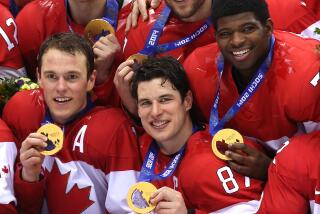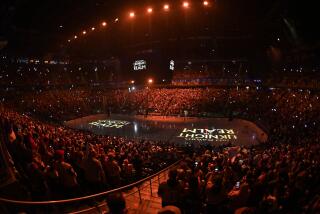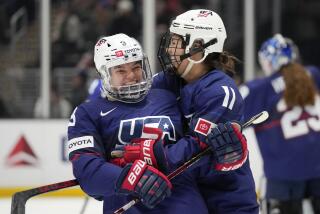Sidney Crosby has grown up in many ways
SOCHI, Russia â He was the NHLâs golden boy, âSid the Kid,â long before he scored the golden goal at Vancouver in 2010 that restored Canadaâs supremacy at the game it claims as its own. Pittsburgh Penguins center Sidney Crosby was 22 when he added an Olympic gold medal to the Stanley Cup title he had won eight months earlier and his future appeared to be limitless.
The Crosby who will lead defending champion Canada against Norway at the Bolshoy Ice Dome on Thursday, isnât a kid anymore. Physically heâs more solid; off the ice, heâs more cognizant of his duties as the face of the NHL.
Heâs also more mature, a process accelerated by a concussion that pushed him through the netherworld of brain injuries and their frightening consequences.
FRAMEWORK: View the best images from the Sochi Olympics
Crosby initially complained only of neck discomfort after he took a shoulder to the head from Washingtonâs David Steckel on Jan. 1, 2011. Four days later, his head was driven into the boards by Tampa Bayâs Victor Hedman and he left the lineup. He didnât return until Nov. 21, 2011, and lasted only eight games â in which he racked up 12 points â before dizziness and other symptoms took him out again.
He had genuine reason to fear his career might have ended.
âAugust 2011 was a tough month for him, especially the mid part,â said his agent, Pat Brisson of CAA. âHe is usually getting close to the start of training camp at that time and still had major symptoms.â
Treatments from Ted Carrick, a chiropractic neurologist, brought Crosby some relief. The discovery in January 2012 that he had damaged several vertebrae allowed for more precise treatment, and he returned in mid-March. âHe went forward from that point on,â Brisson said.
Except, that is, for a broken jaw last season that cost him 12 regular-season games and the Penguinsâ first playoff contest. But he was as lucky as someone with a surgically repaired face and ravaged teeth could be, because he experienced none of the darkness that had enveloped him after the concussion.
He has remained symptom-free, and his play reflects that. Going into the final day before the NHLâs Olympic break, Crosby held the scoring lead with 78 points in 58 games, including a league-best 50 assists.
âI feel really good. No complaints at all there,â he said during a recent visit to Los Angeles. âI think coming into a lockout year last year probably helped a little. Not having to come in and play a full year after missing that much time, I was able to ease my way into it a bit more. I got a regular summer and was able to get ready for the season.
âSo Iâm happy with the way I feel, and I just want to make sure I keep it on the same track.â
His track runs higher than almost everyone elseâs. He has elevated his game by gaining a deeper comprehension of whatâs happening around him, a calm that allows him to make better decisions.
Crosby attributes the difference to age and experience.
âYou continue to learn as you get older and go through situations and meet different guys and play different teams. All that stuff,â he said. âI think it all helps. You always want to learn. You always want to get better. Iâve always tried to keep that in mind every year.â
But Penguins teammate and linemate Chris Kunitz thinks thereâs more behind Crosbyâs progression.
âI think itâs understanding situations and limiting some of the frustration that comes from playing the game,â said Kunitz, who is expected to skate alongside Crosby for Team Canada. âHe thinks the game at such a high level. For the rest of us it doesnât come that smooth. So when things donât happen as quick heâs done a great job of helping guys along or talking to guys on the bench.
âEveryone knows how hard he works in practice, and thatâs one thing that has never changed. He still loves to have fun out there, but heâs also working. Heâs doing everything with a purpose.â
Penguins Coach Dan Bylsma, who is coaching Team USA, also sees Crosbyâs continued work ethic and new grasp of the game as fueling his ascent to a higher plane.
âIf you watch a highlight, youâre going to see an amazing play, but the consistency at which you see him play at that level is really the thing that heâs gone to another level in,â Bylsma said.
The coach also said he has seen Crosby improve on defense, an area in which Crosby had lagged in his early years.
âI think his game is even rounded out more on both sides of the puck,â Bylsma said. âHe finds himself with our team this year in a lot of matchup situations, where weâre matching him up against the other teamâs top line, or in defensive situations, in addition to being the best player at the other end of the rink as well.â
Crosby has to add another dimension to his game in Sochi. The Olympic tournament is being played on 100-foot-wide international-size rinks, 15 feet wider than NHL surfaces. Crosby recalled having played on the bigger ice only three times. He must adapt quickly, but heâs done that before.
âThe foundation of your game, itâs not going to change no matter how big the ice is,â he said. âBut itâs good to know those little things and try to remind myself about those things as you get closer.â
Twitter: @helenenothelen
More to Read
Go beyond the scoreboard
Get the latest on L.A.'s teams in the daily Sports Report newsletter.
You may occasionally receive promotional content from the Los Angeles Times.







